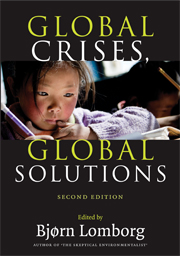Book contents
- Frontmatter
- Contents
- List of figures
- List of tables
- List of contributors
- Acknowledgements
- List of abbreviations and acronyms
- Introduction
- PART I THE CHALLENGES
- 1 Air pollution
- 2 The security challenge in conflict-prone countries
- 3 Disease control
- 4 The benefits and costs of alternative strategies to improve educational outcomes
- 5 Climate change
- 6 Hunger and malnutrition
- 7 Water and sanitation
- 8 The challenge of reducing international trade and migration barriers
- 9 Transnational terrorism
- 10 Women and development
- PART II RANKING THE OPPORTUNITIES
- Conclusion
8 - The challenge of reducing international trade and migration barriers
Published online by Cambridge University Press: 05 June 2012
- Frontmatter
- Contents
- List of figures
- List of tables
- List of contributors
- Acknowledgements
- List of abbreviations and acronyms
- Introduction
- PART I THE CHALLENGES
- 1 Air pollution
- 2 The security challenge in conflict-prone countries
- 3 Disease control
- 4 The benefits and costs of alternative strategies to improve educational outcomes
- 5 Climate change
- 6 Hunger and malnutrition
- 7 Water and sanitation
- 8 The challenge of reducing international trade and migration barriers
- 9 Transnational terrorism
- 10 Women and development
- PART II RANKING THE OPPORTUNITIES
- Conclusion
Summary
The net economic and social benefits of reducing most government subsidies and opening economies to trade are enormous relative to the costs of adjustment to such policy reform. While barriers to trade in most goods and some services including capital flows have been reduced considerably over the past two decades, many remain. Such policies harm most the economies imposing them, but the worst of the merchandise barriers (in agriculture and textiles) are particularly harmful to the world's poorest people, as are barriers to worker migration across borders. Addressing this challenge would therefore also assist in meeting several of the other challenges identified in this project, including malnutrition, disease, poor education and air pollution.
This chapter focuses on how costly those anti-poor trade policies are, and examines possible strategies to reduce remaining distortions. Three opportunities in particular are addressed. The most beneficial prospect is the Doha Development Agenda of the World Trade Organization (WTO). If that proves to be too difficult politically to bring to a conclusion in the near future, the other two prospects we consider are sub-global preferential reforms such as the Free Trade Area of the Americas (FTAA) initiative, and the freeing up of the international movement of workers.
The chapter begins by defining the challenge. It then summarizes the arguments for removing trade and migration distortions, along with critiques by skeptics, before discussing the various opportunities for reducing subsidies and trade barriers and explaining why we chose to focus on the above-mentioned three.
- Type
- Chapter
- Information
- Global Crises, Global SolutionsCosts and Benefits, pp. 451 - 515Publisher: Cambridge University PressPrint publication year: 2009
- 3
- Cited by



